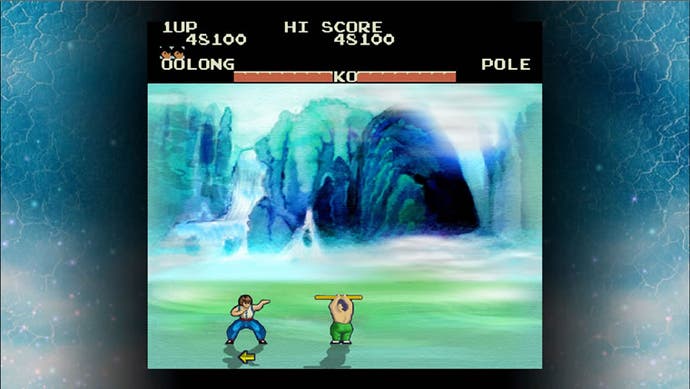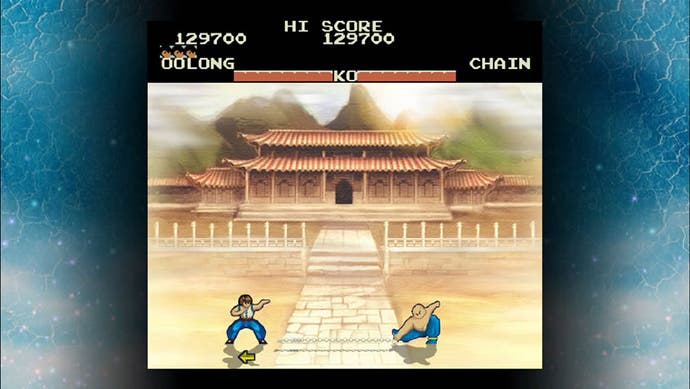Yie Ar Kung-Fu
I know Kung-Fu, and this definitely isn't it.
Aw. This one takes me back - to a time when cheeky chappies Ocean [a.k.a. Imagine] used to lovingly port all of Konami's arcade hits to every 8-bit format going. Sadly, for every Green Beret, Hyper Sports or Mikie, there was a Comic Bakery, Shaolin's Road or, urk, Yie-Ar Kung Fu. Folks: if it wasn't that great back then, you can bet your bottom dorrar that 22 years on it won't be the best 400 points you could feasibly commit to spending down at the Xbox Live Arcade.
We make no apologies for the tough love shown to many so-called old classics around here, but Yie Ar Kung-Fu does deserve credit for many of the ideas it helped introduce to the one-on-one beat 'em up scene. Although today it looks like astonishingly primitive in practically every regard, it grabbed gamers' attention in 1985 by offering eleven distinctly different opponents to face-off against - each with their own attack patterns, and/or weapons to add to the challenge and variety. Also - and it sounds ridiculous now - the animated backdrops were a big deal back in the day. Then again, colour gaming in general was a still a novelty, so cut us some slack on that point, eh?
Bo selecta
In short, the variety of foes you faced were the most interesting aspect of the game as each and every one was vastly better equipped for the fight than you. There was Star, with her evil, relentless shuriken throwing attacks, Nuncha with his swinging Nunchucks, Fan with her, er, razor-sharp fans of death, Sword with his aerial moves and swinging blade, or Pole, an indignant little tubby fellow with Short Man syndrome. And a pole to poke you with, obviously.
Other fighters were variations on a theme, but there was a sense of excitement from progressing through each stage and not knowing what to expect from your next foe. Each demanded a slightly different approach, and with just three lives (plus extras) with which to fall back on, you'd often find yourself clinging on by the skin of your teeth to get through. It wasn't renowned for being a particularly fair game, but in a way, '80s gamers were used to being tested to the limit. At least it wasn't a one hit kill game, and was one of the first to introduce the now-standard concept of having a health bar.

The move set was also quite expanded for its time, with a separate button assigned to kick and punch, and an array of moves that corresponded to all eight directions of the controller, with crouch and jump moves in the mix. To even point that out seems silly now, but at the time it was, again, quite a fleshed out control system. Sadly, in pretty much every other respect, Yie Ar Kung-Fu is saddled with some of the most curious design decisions in beat 'em up history. For example, you can't block, can't perform a jumping attack, and - most crucially - the hit detection system is all over the place.
Foe fighters
Much of the time your blows seem to go right through your opponent, which is not only monumentally unfair, but completely ruins the fun. You could perhaps tolerate the complete lack of animation if there was a sense of fair play and consistency in the combat system, but it's utterly hobbled to the extent that bouts descend into a game of chance where you, comically, bounce around the screen and try and fit in a kick or punch when you get the opportunity.. Sometimes you win because the game registers your blows, other times you'll lose because it doesn't. Cue frustration.
As with all the Konami games ported to Xbox Live Arcade, you get a bog standard Enhanced mode which helps smooth out the chunky sprites, but does very little to disguise the primitive nature of the graphics. It's a minor improvement that helps the game look a little better on a big TV, but it's not something that helps masks any of the glaring flaws in the rest of the game.

Elsewhere, Konami has at least added online multiplayer modes to add a flicker of interest. As per usual you get ranked or player matches for the competitive (i.e. score-based) mode, along with a co-operative mode. Because of the general lack of interest in this lacklustre title, not one single person wanted to play this online in a half hour period that we spent in the lobby, so it's hardly something that's a major facet of the game. Lump in the usual achievements and leaderboards, and there's a smidgen of added value, but you'd be clutching at straws to suggest that these elements make it worth buying.
Microsoft has been heavily criticised for the quality of some of the retro offerings that have appeared on Xbox Live Arcade, and rightfully so. With literally hundreds of better classic games out there to choose from, it's absolutely mystifying that something that's aged as badly as Yie Ar Kung-Fu can be held aloft as some sort of period piece worth re-investigating. By all means give Konami some credit for its place in helping to create the beat 'em up genre as we know it, but download the free trial and spare yourself the painful comedy of actually playing it.
[Editor's note: Some Konami apologist have incorrectly hailed Yie Ar Kung-Fu as the best pre-Street Fighter II beat 'em up, but let's blow that theory apart right here, right now. That particular honour fell to Archer Maclean's legendary IK+, and before it, Beam Software's beloved Way of the Exploding Fist. If you've never played them, track down the Amiga version of IK+ and the C64 version of Exploding Fist and see what the fuss is about.]








